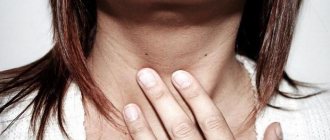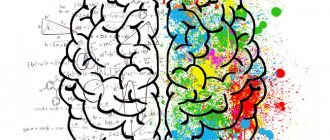Signs and manifestations
In early childhood, babies perform many unconscious actions. For example, babies open their mouths slightly when they move their arms and legs, but this goes away before they reach one year of age. The older the child, the fewer accompanying movements he makes. This tendency is considered normal.
There are age norms for the amount of synkinesis associated with fine motor skills:
- 6 years - up to ten reflex movements;
- 7 years - about six;
- 8 years - five, etc.
Today's children have greater motor retardation than their predecessors because today's lifestyle requires less manual labor. Synkinesis also develops as an independent symptom of damage to the nervous system or its parts.
Opening hours: 8:00 to 20:00
Telephone
Sign up
Today's children have greater motor retardation than their predecessors because today's lifestyle requires less manual labor. Synkinesis also develops as an independent symptom of damage to the nervous system or its parts.
Children's synkinesis
Quite simple tests help make sure that everything is not all right with the baby. They can be made at home.
A child with synkinesis either cannot perform at all or incorrectly performs seemingly elementary exercises. So, let's check it out?
- Ask your child to consistently connect the thumb with all the fingers on the same hand.
- Show your baby the “ring” combination by connecting your thumb and index finger, and then ask him to do the same first on one hand, then on the other. At 4 years old, you can still help the child by explaining to him which fingers should be involved in the work. Then it will be more difficult to do.
- Show your baby the “goat” combination on your hand by extending your index finger and little finger forward from your fist. Ask him to do the same on one and then on the other hand. Make sure that the “right” fingers are involved in the work: so that the thumb does not go to the side and that the baby does not help himself with the other hand. You can discuss in advance with a 4-year-old child which fingers will participate in the game.
- Show the child the “victory” sign on one hand - the index and middle fingers raised up. Ask him to repeat this gesture first on one hand, then on the other. Make sure your fingers are straight when performing the test.
- Here is a test that allows you to check your child’s interhemispheric coordination. To do this, pour white and red beans into a bowl. Ask your child to pick up white beans with his left hand and red beans with his right hand. This must be done simultaneously, placing the beans on two different plates.
Strictly speaking, synkinesis is involuntary cooperative movements. They are present in almost every person.
For example, when we walk, we wave our arms or, when we touch up our eyelashes, we stick out our tongue out of zeal. But this is synkinesis, which does not interfere with our lives.
The problem with childhood synkinesis is that the child requires much more effort to learn than his peers. The energy that could be spent on attention and performance is instead used to compensate for additional and completely unnecessary movements. For example, a baby draws and at the same time actively moves his tongue. Or during some activity his lips suddenly begin to move.
When a child’s tongue works together with his hand, it means that one center in his brain is responsible for both three fingers and the tongue. And this center takes in three times more energy than it should. One center in the brain may integrate fingers and vision. And then, simultaneously with the work of the fingers, the eyes strain, and the child incorrectly copies the tasks from the board. This is not because he is inattentive. As soon as he raises his head to look at what is written on the board, his eye stops working “correctly.” He randomly snatches only pieces from what the teacher wrote on the blackboard. There was a case when a child was brought to a surgeon for a consultation, whose legs began to hurt during classes in the first grade. The most surprising thing is that the cause was again synkinesis. As soon as the child took the pen and began to write, the muscles in his legs tensed and the baby’s legs cramped.
Why is it so important to hold a pencil and pen correctly? The answer is as simple as two: this is how we spend the least effort on writing, without straining our hand. This means that a lot of energy is saved for other activities: for example, you can simultaneously listen to explanations or copy from the board. And if you take the pencil incorrectly and the elbow hangs in the air, then the child will spend enormous effort just to keep his hand in the desired position.
A child with synkinesis gets tired much faster and his performance decreases. Yes, this is understandable: after all, his energy reserve is eaten up by the movements accompanying writing, which he does not need at all! If the baby is tired, it means that he perceives little and needs to immerse himself in order to accumulate energy. What if there is a lesson going on at this time? Techniques of specialists for working with such children are usually based on motor exercises and drug treatment.
Modern treatment of synkinesis
Before starting treatment for synkinesis, it is necessary to conduct a series of diagnostic examinations and establish the exact cause of the appearance of unpleasant symptoms. For diagnosis, X-rays, MRI, CT, vascular ultrasound, electromyography, neurography, EEG and many other methods are used.
To make a diagnosis, you need to contact a neurologist. This specialist will conduct an examination and prescribe additional examinations as necessary. After making an accurate diagnosis, the doctor develops an individual treatment plan that takes into account the potential cause, the general condition of the patient, and the degree of advanced disease.
In our manual therapy clinic, treatment of synkinesis is carried out using absolutely safe and effective techniques. We have accumulated extensive experience in the complete restoration of the functions of the central and nervous system.
We use the following types of treatment in treatment:
- manual traction of the spinal column, if involuntary muscle contractions are associated with pathologies of its tissues;
- reflexology – due to acupressure, the hidden reserves of the human body are activated, tissue regeneration processes are launched;
- osteopathy improves microcirculation of blood and lymphatic fluid in the affected areas;
- therapeutic exercises and kinesiotherapy allow the formation of correct neural connections and strengthen the muscular frame of the human body;
- physiotherapy improves metabolic processes in tissues;
- massage relieves excess tension and promotes the correct conduction of nerve impulses.
If you need safe and effective treatment for synkinesis, we suggest you make a free appointment with a neurologist right now. The doctor will conduct an examination and give individual recommendations for complex therapy. Fill out the registration form located further down the page.
Basic diagnostic methods
Diagnosis in case of synkinesis is carried out in the following ways:
- Visual inspection . In this case, the patient must be examined by a neurologist who monitors voluntary movements.
- Carrying out magnetic resonance imaging.
- Fluoroscopy . It consists of illuminating the entire body in both horizontal and vertical positions.
- Electromyography of skeletal muscles . This is a method for diagnosing damage to the neuromuscular system, which consists of recording the electrical activity of skeletal muscles. Even in the presence of primary muscle damage, a decrease in the amplitude of oscillations is already noted.
- Comprehensive test of leg reflexes . Diagnosis takes place in the supine position. When you lift your leg up, tension occurs on the sciatic nerve. Therefore, if involuntary movement of other joints or limbs is observed, this indicates the presence of one of the types of synkinesis.
- Electroencephalography . It consists of checking the functional state of the brain. Allows you to determine the presence of nerve spasms.
- Carrying out neurosonography .
Since synkinesis is very often accompanied by a number of other diseases, diagnosis cannot be quick and unambiguous. In addition to the above research methods, the patient must undergo an examination by an otolaryngologist, neurosurgeon, dentist and ophthalmologist.
Pathological and oral synkinesis: causes, symptoms, diagnostic methods and treatment
The concept of synkinesis
Synkinesis is a conjugal movement of a muscle group that impulsively originates in one area of the body or face, synchronously with the passive movement of another limb.
Modern therapeutic practice classifies attacks into several main types, among which pathological ones occur. In this case, reflex movements originate in the paralyzed area of the body or limb, together with purposeful movements of the opposite, healthy areas.
The syndrome is noted against the background of the irradiating properties of impulses that arrive and are activated in the cerebral cortex to nearby neurons.
Types of synkinesis and their main characteristics
Physiological synkinesis is especially acute in childhood. Newborns and children under one year of age often accompany active movements of the limbs with reflex contractions of the muscle tissue of the mouth and tongue. Synkinesis in infancy is more common as an awakening of primitive motor skills.
With gradual growth and development, unnecessary movements disappear. Synkinesias are also found in speech therapy: they are expressed in the involuntary upward lifting of the lower jaw when trying to carry out the traditional articulatory process with the tip of the tongue and press it to the palate during speech.
Facial synkinesis
They manifest themselves as complications of neuropathy and aberrant regeneration of the facial nerve.
The syndrome is expressed in a sharp tension of the facial facial muscles, which is accompanied by a global contraction of the remaining muscles.
Such a violation can cause the patient a lot of problems and discomfort.
The clinical picture of this type is expressed in the following syndromes:
- Eyelid-labial synkinesia - when the eyelid droops, the corner of the mouth rises;
- Eyelid-frontal synkinesia - the closure of the eyelids is accompanied by an involuntary wrinkling of the forehead;
- Eyelid-platysmal synkinesia - squinting or squinting of the eyes is complemented by tension in the subcutaneous muscle of the cervical region;
- Eyelid-auricular synkinesis - when the eyelids are sharply closed or the eyes are closed, the corner of the auricle involuntarily rises upward;
- Guyer's synkinesis - straining of the orbicularis oculi muscle is accompanied by upward lifting of the wing of the nose on the same side;
- Labial-palpebral - the palpebral fissure narrows and creates the effect of squinting when eating, pronouncing words, puffing out the cheeks, closing the lips into a tube, or stretching them out;
- Frontolabial - a friendly rise in the corners of the mouth when the forehead is wrinkled;
Treatment of facial synkinesis takes place in conjunction with treatment of the underlying disease.
Crocodile tears syndrome
It is expressed by lacrimation of medium and high intensity, observed in one or another part of the face when chewing food or moving the lower jaw.
Oral synkinesis
Characterized by acute dysfunctions of oral automatism, however, are considered a relatively normal phenomenon for infants. Symptoms of oral synkinesis are noted immediately after birth, its signs noticeably weaken by the third month of life, and disappear completely after a year.
The persistence and evolution of this dysfunction can have a detrimental effect on the formation of the speech apparatus and inhibit targeted articulatory movements.
As a result, a number of speech therapy problems arise that tend to persist throughout life:
- Pronunciation disorder of consonants and vowels (average/reduced);
- Palatalization (perceptible softening of hard sounds);
- Interdental, lateral and palatal reproduction of hissing and whistling sounds;
- General slurring of speech, feeling of the patient's mouth being full when speaking.
Pathological synkinesis
They manifest themselves in conjugal movements of the limb affected by central hemiparesis, with identical voluntary movement of the healthy part of the body. They are divided into coordinating and imitation reflexes.
In the first case, they arise due to a general contraction of a functionally related muscle group; in the second, they are a phantom mirror reproduction of movements performed by a healthy limb.
If you are interested in whether gymnastics helps with inflammation of the sciatic nerve, then you can look here.
Synkinesia with dysarthria
They are a consequence of speech disorders and tend to intensify during psycho-emotional stress. The patient has difficulty voluntarily weakening the organs of the speech apparatus, chewing food may be inhibited and distorted, and sometimes there is profuse salivation when talking.
General disorders are accompanied by tremor of the tongue, irregular muscle contractions, involuntary withdrawal of the lower jaw down or up when the tip of the tongue is tense.
Marcus-Gunn syndrome (Celido-mandibular synkinesis)
It is expressed in obvious early ptosis of one of the eyelids (descent of tissue). May be a congenital or acquired problem.
Overhang is observed mainly in a quiet position of the eyes, when the gaze is directed straight. When chewing, swallowing, sucking and other active movements of the lower jaw, the eyelid of the affected eye is driven into an intense blinking movement.
Causes of synkinesis
Previously, doctors were of the firmly rooted opinion that synkinesia resulting from neuritis was an irreversible pathology.
This is due to incorrect regeneration of the facial nerve after a violation of its integrity.
However, some clinical studies have proven that the causes of synkinesis can be varied, and therefore they can be treated, including surgery.
The causes of the syndrome include the following factors:
Symptoms
Friendly movements in the limbs can occur in absolutely healthy people. The first example of this is running, jumping, or other sports activity. With intense load on the legs and their rapid movement, a person’s upper limbs spontaneously move.
This type of synkinesis is physiological and is an absolutely normal phenomenon. Pathological synkinesis is classified into three types: imitation, coordinator and global.
The clinical picture of the disorder is manifested in the following signs:
- Disorders of facial movements - involuntary squinting of the eyes or movement of the lips against the background of activation of the jaw or eyelids;
- Manifestation of flexion contracture in the paretic upper limb and extension contracture in the lower. Activated when trying to make a movement with paralyzed parts of the body;
- Mirror repetition of movements of healthy parts of the body with paralyzed limbs;
- Performing active additional movements with paralyzed limbs while attempting a purposeful motor act with the whole body;
- Increased intensity of tendon reflexes.
Diagnostic methods
Since the syndrome can be caused by a number of concomitant diseases and disorders, the diagnosis of synkinesis cannot be quick and unambiguous.
In addition, the patient may require an in-person examination by an otolaryngologist, ophthalmologist, dentist, and neurosurgeon. The syndrome can be directly related to certain diseases of the maxillofacial system, ENT organs and even teeth.
Differential diagnosis consists of the following steps:
- Visual examination by the attending physician with observation of voluntary movements;
- Electromyography of skeletal muscles;
- When global synkinesis is detected, observe the patient’s purposeful attempt to perform a motor act with paretic limbs;
- With - imitative synkinesis - irritation by the examiner of a healthy limb in order to observe the presence or absence of imitating involuntary movements of a paralyzed part of the body;
- MRI (magnetic resonance imaging);
- Ultrasound examination of the brain;
- CT scan of the brain (if it is not possible to perform an MRI);
- Electroencephalography.
Let's talk about cardioneurosis. In everyday life we encounter it quite often. The whole truth about this disease and methods of its treatment.
Let's try to understand the consequences of a brain injury. The following link will help us with this.
Therapeutic measures
Since the syndrome rarely develops as an independent lesion of muscles and nerves, doctors prefer to find out the true cause before starting intensive therapy.
Treatment of synkinesis consists of a set of measures:
- Strengthening general motor activity;
- Physiotherapy;
- Therapeutic massages;
- Restoration of motor functions in case of hemiparesis (central paralysis);
- Drug treatment (if the disease is associated with increased muscle tone, weakening drugs are used: dopamine, cyclodol, mydocalm, tropacin, elatin);
- Surgical interventions (mainly for Marcus-Gunn syndrome);
- Physiotherapeutic procedures;
- Applications of dimexide with the addition of sodium hydroxybutyrate or chlorpromazine.
Forecast and consequences
If the syndrome was identified in infancy and was not treated, or persists after the first year of life, the person may experience further disturbances in motor and speech functions, evolution and progression of the disease.
Identifying the symptoms of synkinesis leads to an adequate diagnosis of concomitant diseases and their effective treatment.
Prevention measures
The syndrome cannot be effectively prevented if concomitant neurological dysfunctions develop. However, even patients suffering from paralysis can avoid the development of such disorders by following simple rules.
- Increased physical activity;
- Therapeutic massages and acupuncture (as prescribed);
- Physiotherapy;
- Timely consultation with a specialist if the development of the syndrome is suspected in adults and children;
- Therapeutic massage;
- Botulinum toxin injections for lesions of the facial muscles.
Fortunately, modern medicine is able to offer many different methods of treating this disorder - from conservative techniques to radical surgical interventions.
Timely detection of a disorder and contacting a specialist will help not only relieve the patient of visual dysfunction, but also return his nervous and reflex systems to a healthy state.
Source: https://getmedic.ru/lechenie/raznoe/18306-lechenie-sinkenizij-posle-nevrita-litsevogo-nerva
Pathological and oral synkinesis: causes, symptoms, diagnostic methods and treatment
Synkinesia is a cooperative movement of a group of muscles that impulsively originates in one area of the body or face, synchronously with the passive movement of another limb.
Modern therapeutic practice classifies attacks into several main types, among which pathological ones occur. In this case, reflex movements originate in the paralyzed area of the body or limb, together with purposeful movements of the opposite, healthy areas.
The syndrome is noted against the background of the irradiating properties of impulses that arrive and are activated in the cerebral cortex to nearby neurons.
Etiology
Previously, doctors and speech therapists believed that it was impossible to cope with this pathology. It was believed that the cause was an irreversible disruption of the innervation of the facial nerve. But further research and clarification of the definition showed that the etiology of synkinesias is extensive, and accordingly, methods can be selected to overcome them. Causes:
- Disorders of the central nervous system (CNS).
- Disorders of the cerebral cortex (CGM).
- Violations of general muscle tone.
- Dysarthria.
- Pathological reflexes.
- Suffered a stroke.
- Improper functioning of facial muscles.
- Traumatic brain injuries.
All of these reasons are serious and require medical knowledge to choose the right treatment. Therefore, children with a history of synkinesis are provided with comprehensive care, including medical care. This increases the efficiency of correction work.
Clinical picture
The main symptoms of the development of synkinesis:
- increased muscle resistance during active movement;
- the appearance of rhythmic contractile movements of individual muscles;
- disturbance of facial movements;
- reflex rhythmic twitching of the feet;
- twitching of the affected limb due to mechanical or thermal influence;
- increased intensity of tendon reflexes;
- the presence of increased muscle tone upon palpation.
Corrective work
To overcome synkinesis you need a complex effect. These are exercises to improve general motor skills and relax muscle tone. Therefore, such patients are often recommended to take up swimming, because it has a beneficial effect not only on motor activity, but also on the nervous system.
Children with synkinesis attend exercise therapy classes and undergo courses of therapeutic massages prescribed by the doctor. If they manifest themselves in articulatory and facial motor skills, then a course of speech therapy massage is added. It should only be performed by a speech therapist who has completed special courses. At home, you can do simple self-massage, which also has a beneficial effect on the facial and articulatory muscles.
For dysarthria, drug treatment is prescribed. It not only stimulates the work of speech centers, but also affects the state of muscle tone.
The sooner parents seek advice from a specialist, the more effective the correction work will be. Overcoming synkinesis has a beneficial effect not only on speech activity, but also on the nervous system and muscle tone.
Physiological motor synkinesis
Motor synkinesis can be natural or physiological. They are considered conditioned reflexes that gradually disappear with age. But some of it remains at the level of automaticity.
Physiological synkinesis is a manifestation of primitive motor skills, caused by insufficient development of the motor and pyramidal centers of the brain. Doctors around the world are sounding the alarm. In the last decade, the number of people who, by the age of 20–25 years, retain sufficient development of motor function of the brain has been increasing. This is due to the fact that many types of housework have become automated. Nowadays, rarely does anyone wash things by hand, sew, knit, embroider, or do carpentry. And all these activities developed fine motor skills of the hands. The result now is that motor physiological synkinesis can occur in adults. It's very difficult to fix this. It is necessary to undergo a long rehabilitation course.









